Taxation Law
VerifiedAdded on 2023/03/23
|8
|2379
|85
AI Summary
This document provides a comprehensive study on taxation law, specifically focusing on the tax consequences of receipts received from personal exertion and rendering services. It discusses the issues, rules, and application of tax laws in relation to income derived from individual effort and expenditures incurred during employment. The document also covers the taxation of prizes, benefits, and capital gains, along with deductions and repairs. References to relevant cases and legislation are provided throughout the document.
Contribute Materials
Your contribution can guide someone’s learning journey. Share your
documents today.
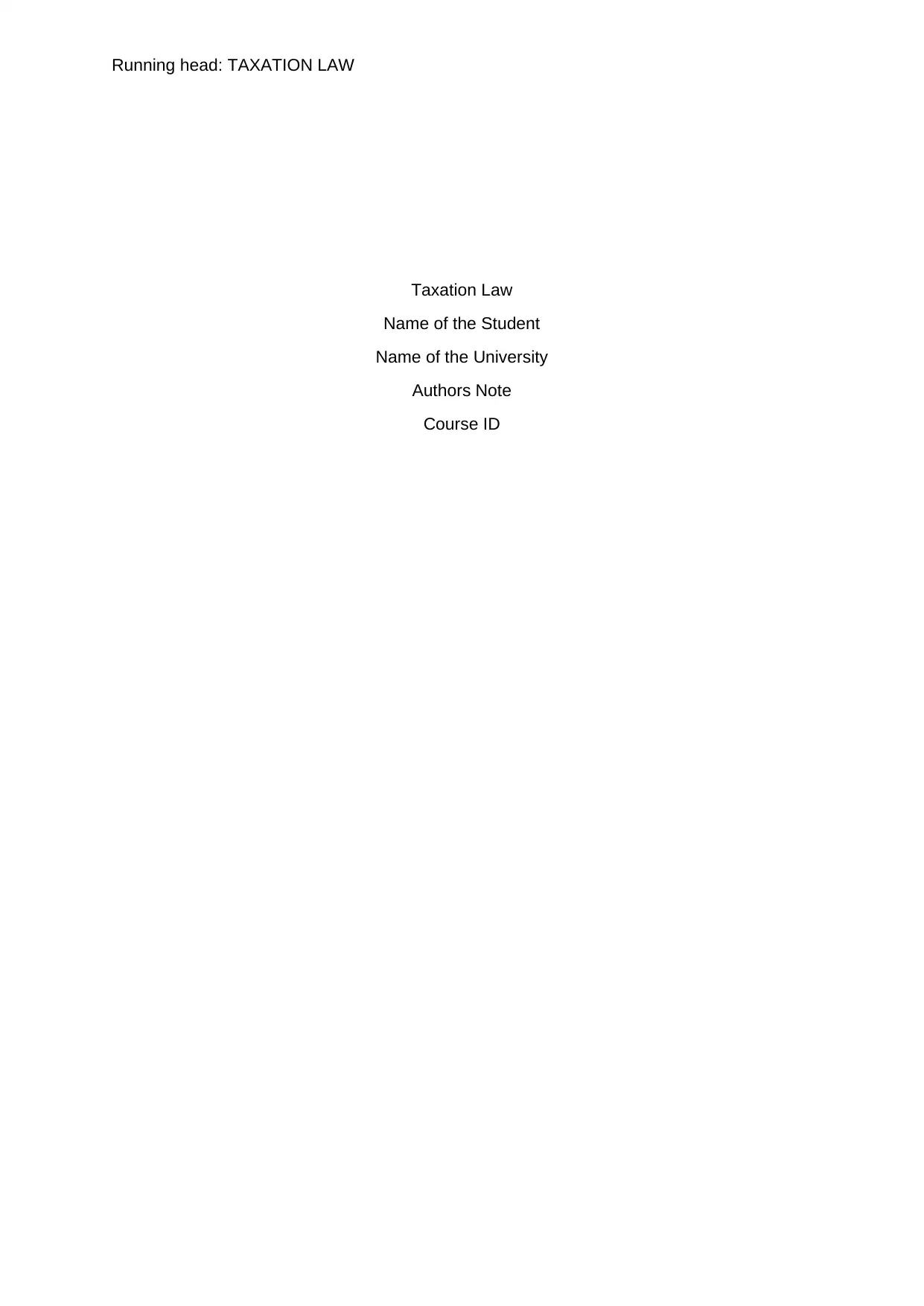
Running head: TAXATION LAW
Taxation Law
Name of the Student
Name of the University
Authors Note
Course ID
Taxation Law
Name of the Student
Name of the University
Authors Note
Course ID
Secure Best Marks with AI Grader
Need help grading? Try our AI Grader for instant feedback on your assignments.
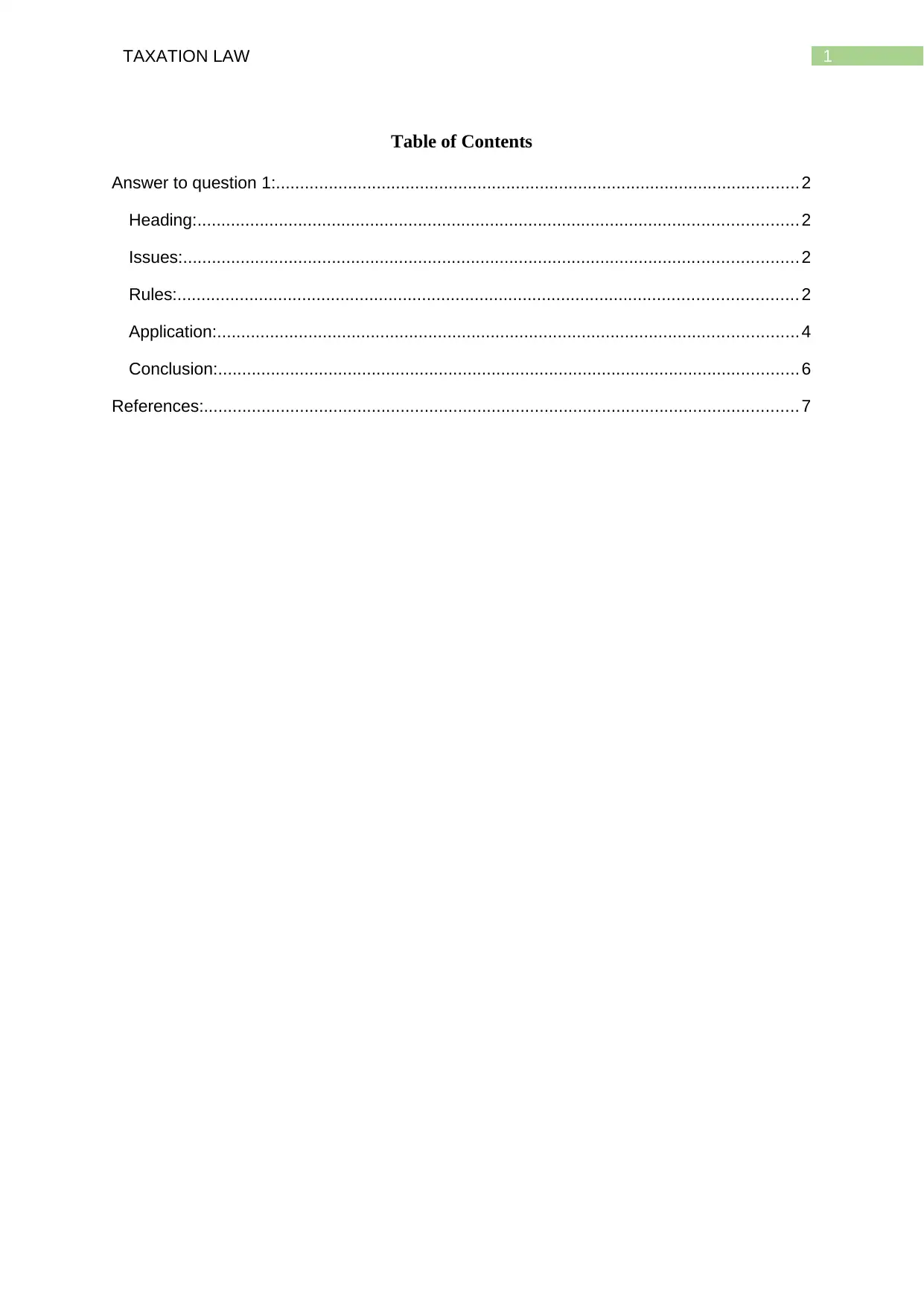
1TAXATION LAW
Table of Contents
Answer to question 1:............................................................................................................. 2
Heading:............................................................................................................................. 2
Issues:................................................................................................................................ 2
Rules:................................................................................................................................. 2
Application:......................................................................................................................... 4
Conclusion:......................................................................................................................... 6
References:............................................................................................................................ 7
Table of Contents
Answer to question 1:............................................................................................................. 2
Heading:............................................................................................................................. 2
Issues:................................................................................................................................ 2
Rules:................................................................................................................................. 2
Application:......................................................................................................................... 4
Conclusion:......................................................................................................................... 6
References:............................................................................................................................ 7
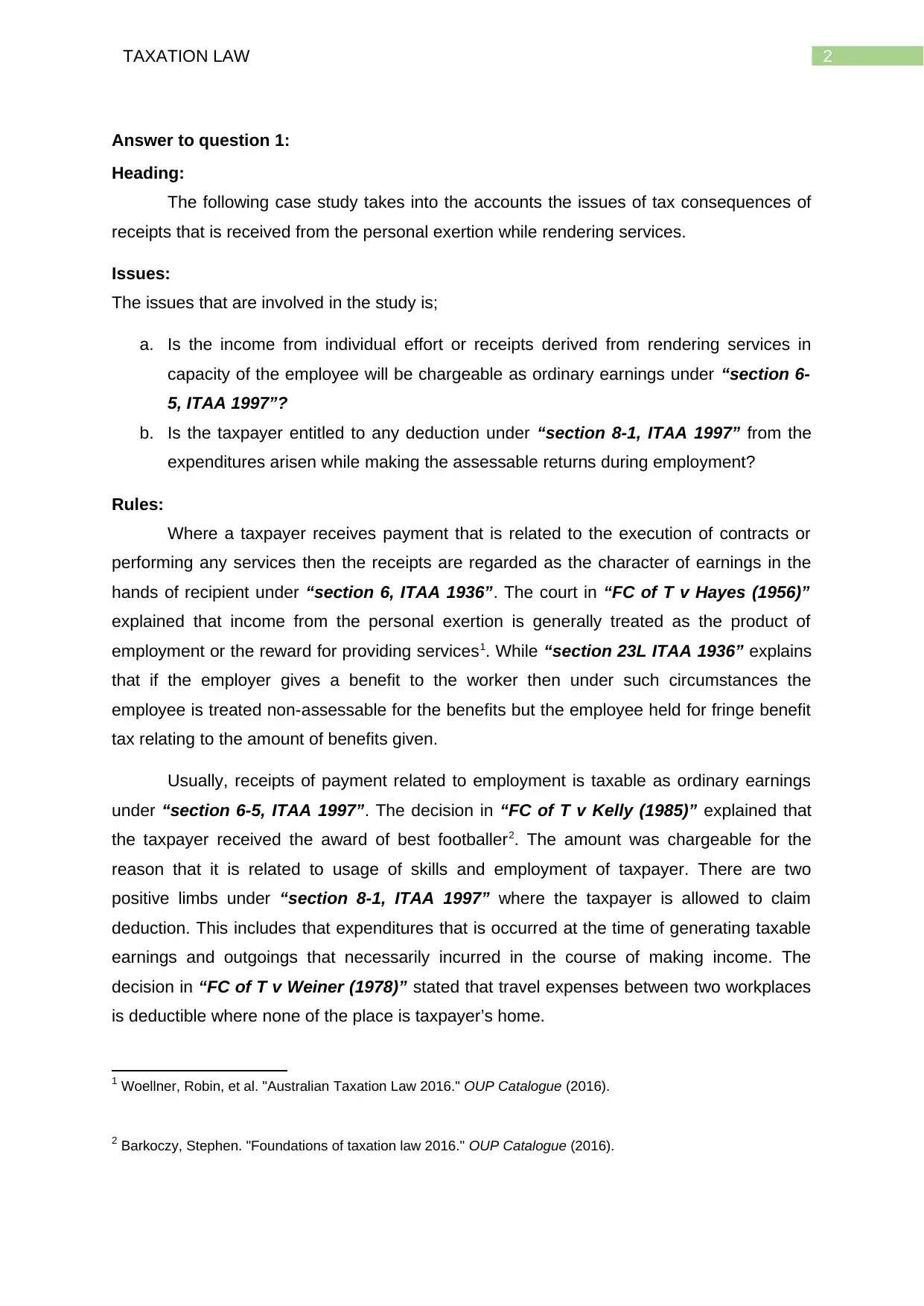
2TAXATION LAW
Answer to question 1:
Heading:
The following case study takes into the accounts the issues of tax consequences of
receipts that is received from the personal exertion while rendering services.
Issues:
The issues that are involved in the study is;
a. Is the income from individual effort or receipts derived from rendering services in
capacity of the employee will be chargeable as ordinary earnings under “section 6-
5, ITAA 1997”?
b. Is the taxpayer entitled to any deduction under “section 8-1, ITAA 1997” from the
expenditures arisen while making the assessable returns during employment?
Rules:
Where a taxpayer receives payment that is related to the execution of contracts or
performing any services then the receipts are regarded as the character of earnings in the
hands of recipient under “section 6, ITAA 1936”. The court in “FC of T v Hayes (1956)”
explained that income from the personal exertion is generally treated as the product of
employment or the reward for providing services1. While “section 23L ITAA 1936” explains
that if the employer gives a benefit to the worker then under such circumstances the
employee is treated non-assessable for the benefits but the employee held for fringe benefit
tax relating to the amount of benefits given.
Usually, receipts of payment related to employment is taxable as ordinary earnings
under “section 6-5, ITAA 1997”. The decision in “FC of T v Kelly (1985)” explained that
the taxpayer received the award of best footballer2. The amount was chargeable for the
reason that it is related to usage of skills and employment of taxpayer. There are two
positive limbs under “section 8-1, ITAA 1997” where the taxpayer is allowed to claim
deduction. This includes that expenditures that is occurred at the time of generating taxable
earnings and outgoings that necessarily incurred in the course of making income. The
decision in “FC of T v Weiner (1978)” stated that travel expenses between two workplaces
is deductible where none of the place is taxpayer’s home.
1 Woellner, Robin, et al. "Australian Taxation Law 2016." OUP Catalogue (2016).
2 Barkoczy, Stephen. "Foundations of taxation law 2016." OUP Catalogue (2016).
Answer to question 1:
Heading:
The following case study takes into the accounts the issues of tax consequences of
receipts that is received from the personal exertion while rendering services.
Issues:
The issues that are involved in the study is;
a. Is the income from individual effort or receipts derived from rendering services in
capacity of the employee will be chargeable as ordinary earnings under “section 6-
5, ITAA 1997”?
b. Is the taxpayer entitled to any deduction under “section 8-1, ITAA 1997” from the
expenditures arisen while making the assessable returns during employment?
Rules:
Where a taxpayer receives payment that is related to the execution of contracts or
performing any services then the receipts are regarded as the character of earnings in the
hands of recipient under “section 6, ITAA 1936”. The court in “FC of T v Hayes (1956)”
explained that income from the personal exertion is generally treated as the product of
employment or the reward for providing services1. While “section 23L ITAA 1936” explains
that if the employer gives a benefit to the worker then under such circumstances the
employee is treated non-assessable for the benefits but the employee held for fringe benefit
tax relating to the amount of benefits given.
Usually, receipts of payment related to employment is taxable as ordinary earnings
under “section 6-5, ITAA 1997”. The decision in “FC of T v Kelly (1985)” explained that
the taxpayer received the award of best footballer2. The amount was chargeable for the
reason that it is related to usage of skills and employment of taxpayer. There are two
positive limbs under “section 8-1, ITAA 1997” where the taxpayer is allowed to claim
deduction. This includes that expenditures that is occurred at the time of generating taxable
earnings and outgoings that necessarily incurred in the course of making income. The
decision in “FC of T v Weiner (1978)” stated that travel expenses between two workplaces
is deductible where none of the place is taxpayer’s home.
1 Woellner, Robin, et al. "Australian Taxation Law 2016." OUP Catalogue (2016).
2 Barkoczy, Stephen. "Foundations of taxation law 2016." OUP Catalogue (2016).
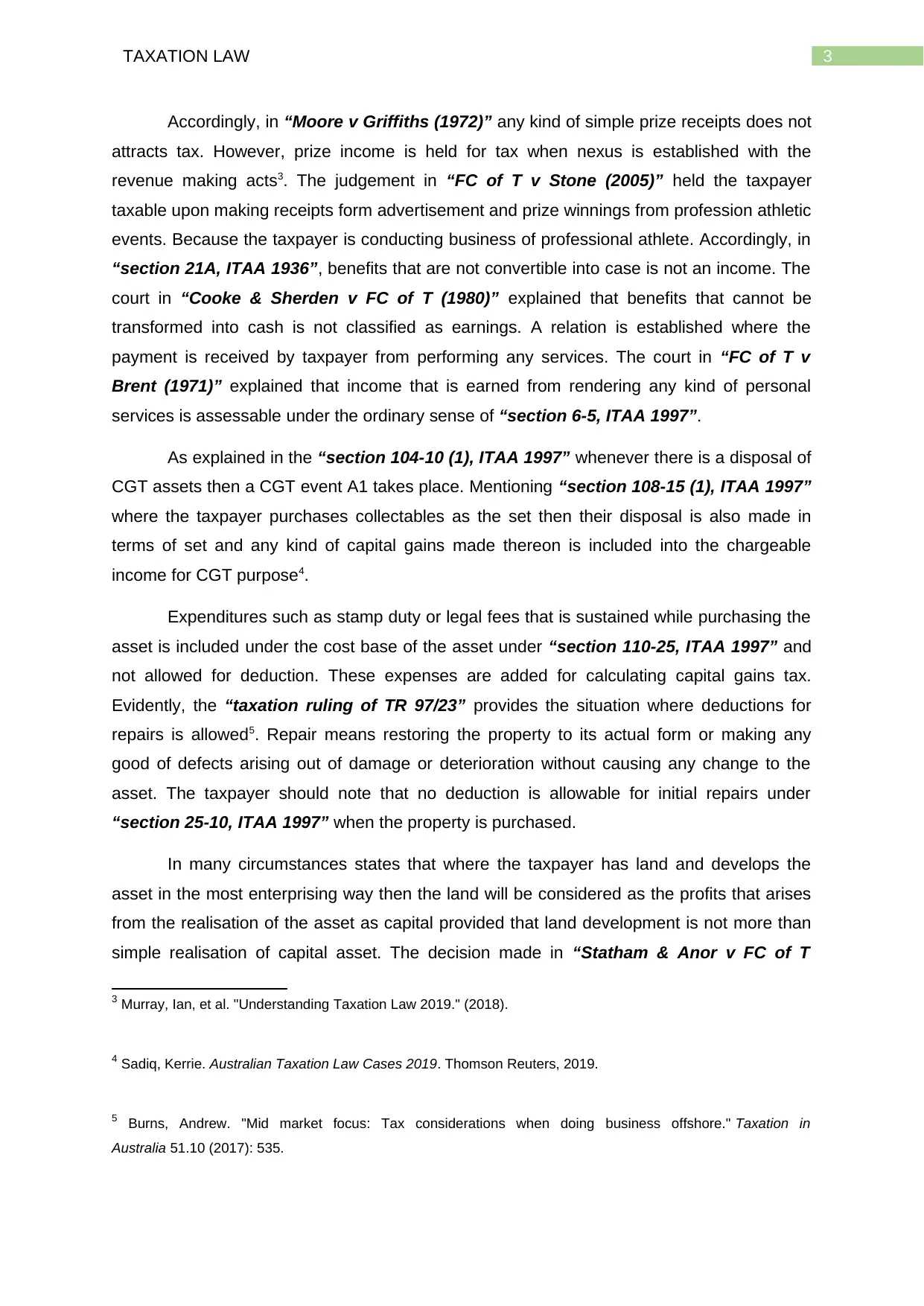
3TAXATION LAW
Accordingly, in “Moore v Griffiths (1972)” any kind of simple prize receipts does not
attracts tax. However, prize income is held for tax when nexus is established with the
revenue making acts3. The judgement in “FC of T v Stone (2005)” held the taxpayer
taxable upon making receipts form advertisement and prize winnings from profession athletic
events. Because the taxpayer is conducting business of professional athlete. Accordingly, in
“section 21A, ITAA 1936”, benefits that are not convertible into case is not an income. The
court in “Cooke & Sherden v FC of T (1980)” explained that benefits that cannot be
transformed into cash is not classified as earnings. A relation is established where the
payment is received by taxpayer from performing any services. The court in “FC of T v
Brent (1971)” explained that income that is earned from rendering any kind of personal
services is assessable under the ordinary sense of “section 6-5, ITAA 1997”.
As explained in the “section 104-10 (1), ITAA 1997” whenever there is a disposal of
CGT assets then a CGT event A1 takes place. Mentioning “section 108-15 (1), ITAA 1997”
where the taxpayer purchases collectables as the set then their disposal is also made in
terms of set and any kind of capital gains made thereon is included into the chargeable
income for CGT purpose4.
Expenditures such as stamp duty or legal fees that is sustained while purchasing the
asset is included under the cost base of the asset under “section 110-25, ITAA 1997” and
not allowed for deduction. These expenses are added for calculating capital gains tax.
Evidently, the “taxation ruling of TR 97/23” provides the situation where deductions for
repairs is allowed5. Repair means restoring the property to its actual form or making any
good of defects arising out of damage or deterioration without causing any change to the
asset. The taxpayer should note that no deduction is allowable for initial repairs under
“section 25-10, ITAA 1997” when the property is purchased.
In many circumstances states that where the taxpayer has land and develops the
asset in the most enterprising way then the land will be considered as the profits that arises
from the realisation of the asset as capital provided that land development is not more than
simple realisation of capital asset. The decision made in “Statham & Anor v FC of T
3 Murray, Ian, et al. "Understanding Taxation Law 2019." (2018).
4 Sadiq, Kerrie. Australian Taxation Law Cases 2019. Thomson Reuters, 2019.
5 Burns, Andrew. "Mid market focus: Tax considerations when doing business offshore." Taxation in
Australia 51.10 (2017): 535.
Accordingly, in “Moore v Griffiths (1972)” any kind of simple prize receipts does not
attracts tax. However, prize income is held for tax when nexus is established with the
revenue making acts3. The judgement in “FC of T v Stone (2005)” held the taxpayer
taxable upon making receipts form advertisement and prize winnings from profession athletic
events. Because the taxpayer is conducting business of professional athlete. Accordingly, in
“section 21A, ITAA 1936”, benefits that are not convertible into case is not an income. The
court in “Cooke & Sherden v FC of T (1980)” explained that benefits that cannot be
transformed into cash is not classified as earnings. A relation is established where the
payment is received by taxpayer from performing any services. The court in “FC of T v
Brent (1971)” explained that income that is earned from rendering any kind of personal
services is assessable under the ordinary sense of “section 6-5, ITAA 1997”.
As explained in the “section 104-10 (1), ITAA 1997” whenever there is a disposal of
CGT assets then a CGT event A1 takes place. Mentioning “section 108-15 (1), ITAA 1997”
where the taxpayer purchases collectables as the set then their disposal is also made in
terms of set and any kind of capital gains made thereon is included into the chargeable
income for CGT purpose4.
Expenditures such as stamp duty or legal fees that is sustained while purchasing the
asset is included under the cost base of the asset under “section 110-25, ITAA 1997” and
not allowed for deduction. These expenses are added for calculating capital gains tax.
Evidently, the “taxation ruling of TR 97/23” provides the situation where deductions for
repairs is allowed5. Repair means restoring the property to its actual form or making any
good of defects arising out of damage or deterioration without causing any change to the
asset. The taxpayer should note that no deduction is allowable for initial repairs under
“section 25-10, ITAA 1997” when the property is purchased.
In many circumstances states that where the taxpayer has land and develops the
asset in the most enterprising way then the land will be considered as the profits that arises
from the realisation of the asset as capital provided that land development is not more than
simple realisation of capital asset. The decision made in “Statham & Anor v FC of T
3 Murray, Ian, et al. "Understanding Taxation Law 2019." (2018).
4 Sadiq, Kerrie. Australian Taxation Law Cases 2019. Thomson Reuters, 2019.
5 Burns, Andrew. "Mid market focus: Tax considerations when doing business offshore." Taxation in
Australia 51.10 (2017): 535.
Secure Best Marks with AI Grader
Need help grading? Try our AI Grader for instant feedback on your assignments.
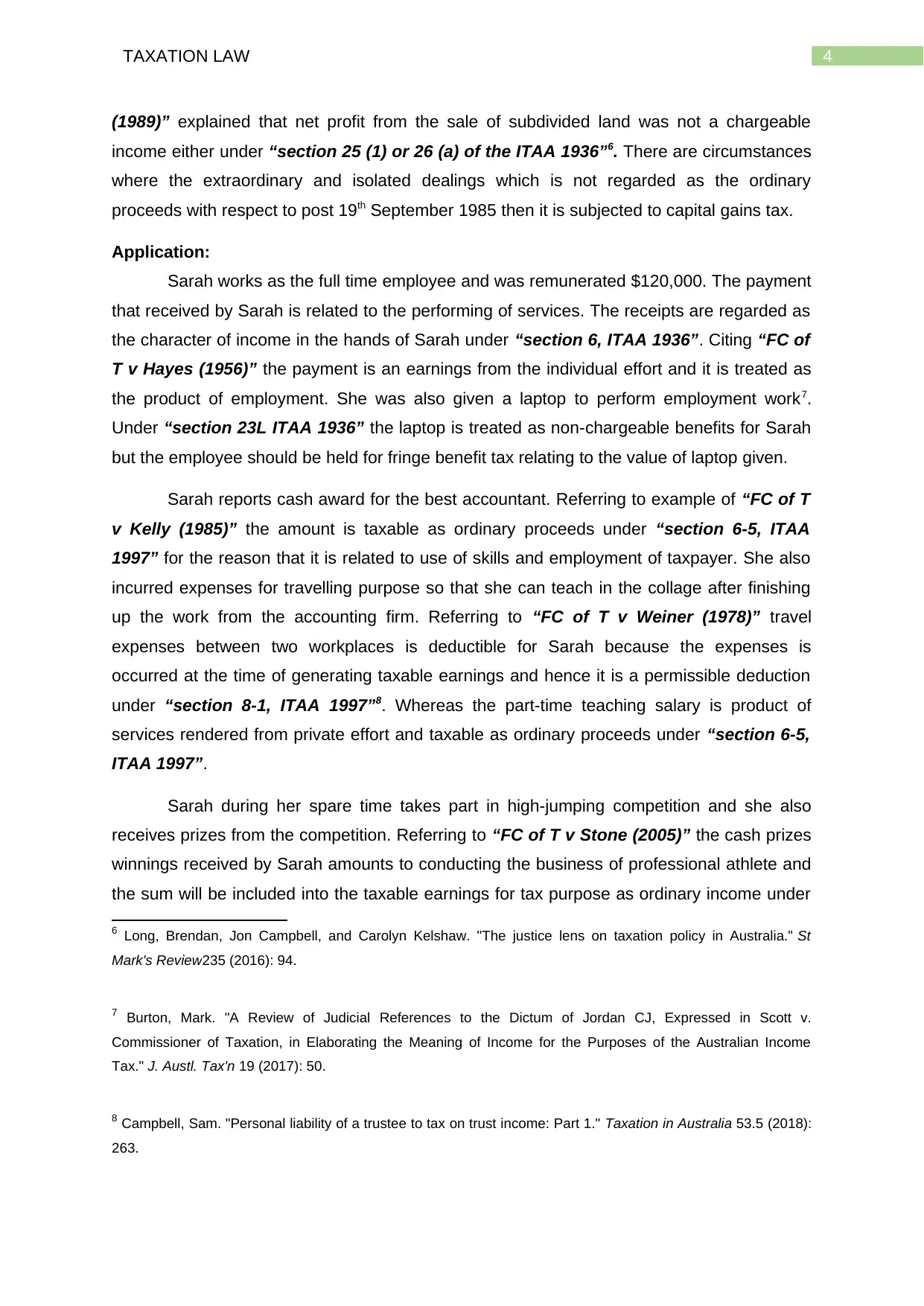
4TAXATION LAW
(1989)” explained that net profit from the sale of subdivided land was not a chargeable
income either under “section 25 (1) or 26 (a) of the ITAA 1936”6. There are circumstances
where the extraordinary and isolated dealings which is not regarded as the ordinary
proceeds with respect to post 19th September 1985 then it is subjected to capital gains tax.
Application:
Sarah works as the full time employee and was remunerated $120,000. The payment
that received by Sarah is related to the performing of services. The receipts are regarded as
the character of income in the hands of Sarah under “section 6, ITAA 1936”. Citing “FC of
T v Hayes (1956)” the payment is an earnings from the individual effort and it is treated as
the product of employment. She was also given a laptop to perform employment work7.
Under “section 23L ITAA 1936” the laptop is treated as non-chargeable benefits for Sarah
but the employee should be held for fringe benefit tax relating to the value of laptop given.
Sarah reports cash award for the best accountant. Referring to example of “FC of T
v Kelly (1985)” the amount is taxable as ordinary proceeds under “section 6-5, ITAA
1997” for the reason that it is related to use of skills and employment of taxpayer. She also
incurred expenses for travelling purpose so that she can teach in the collage after finishing
up the work from the accounting firm. Referring to “FC of T v Weiner (1978)” travel
expenses between two workplaces is deductible for Sarah because the expenses is
occurred at the time of generating taxable earnings and hence it is a permissible deduction
under “section 8-1, ITAA 1997”8. Whereas the part-time teaching salary is product of
services rendered from private effort and taxable as ordinary proceeds under “section 6-5,
ITAA 1997”.
Sarah during her spare time takes part in high-jumping competition and she also
receives prizes from the competition. Referring to “FC of T v Stone (2005)” the cash prizes
winnings received by Sarah amounts to conducting the business of professional athlete and
the sum will be included into the taxable earnings for tax purpose as ordinary income under
6 Long, Brendan, Jon Campbell, and Carolyn Kelshaw. "The justice lens on taxation policy in Australia." St
Mark's Review235 (2016): 94.
7 Burton, Mark. "A Review of Judicial References to the Dictum of Jordan CJ, Expressed in Scott v.
Commissioner of Taxation, in Elaborating the Meaning of Income for the Purposes of the Australian Income
Tax." J. Austl. Tax'n 19 (2017): 50.
8 Campbell, Sam. "Personal liability of a trustee to tax on trust income: Part 1." Taxation in Australia 53.5 (2018):
263.
(1989)” explained that net profit from the sale of subdivided land was not a chargeable
income either under “section 25 (1) or 26 (a) of the ITAA 1936”6. There are circumstances
where the extraordinary and isolated dealings which is not regarded as the ordinary
proceeds with respect to post 19th September 1985 then it is subjected to capital gains tax.
Application:
Sarah works as the full time employee and was remunerated $120,000. The payment
that received by Sarah is related to the performing of services. The receipts are regarded as
the character of income in the hands of Sarah under “section 6, ITAA 1936”. Citing “FC of
T v Hayes (1956)” the payment is an earnings from the individual effort and it is treated as
the product of employment. She was also given a laptop to perform employment work7.
Under “section 23L ITAA 1936” the laptop is treated as non-chargeable benefits for Sarah
but the employee should be held for fringe benefit tax relating to the value of laptop given.
Sarah reports cash award for the best accountant. Referring to example of “FC of T
v Kelly (1985)” the amount is taxable as ordinary proceeds under “section 6-5, ITAA
1997” for the reason that it is related to use of skills and employment of taxpayer. She also
incurred expenses for travelling purpose so that she can teach in the collage after finishing
up the work from the accounting firm. Referring to “FC of T v Weiner (1978)” travel
expenses between two workplaces is deductible for Sarah because the expenses is
occurred at the time of generating taxable earnings and hence it is a permissible deduction
under “section 8-1, ITAA 1997”8. Whereas the part-time teaching salary is product of
services rendered from private effort and taxable as ordinary proceeds under “section 6-5,
ITAA 1997”.
Sarah during her spare time takes part in high-jumping competition and she also
receives prizes from the competition. Referring to “FC of T v Stone (2005)” the cash prizes
winnings received by Sarah amounts to conducting the business of professional athlete and
the sum will be included into the taxable earnings for tax purpose as ordinary income under
6 Long, Brendan, Jon Campbell, and Carolyn Kelshaw. "The justice lens on taxation policy in Australia." St
Mark's Review235 (2016): 94.
7 Burton, Mark. "A Review of Judicial References to the Dictum of Jordan CJ, Expressed in Scott v.
Commissioner of Taxation, in Elaborating the Meaning of Income for the Purposes of the Australian Income
Tax." J. Austl. Tax'n 19 (2017): 50.
8 Campbell, Sam. "Personal liability of a trustee to tax on trust income: Part 1." Taxation in Australia 53.5 (2018):
263.

5TAXATION LAW
“section 6-5, ITAA 1997”9. Beside the prize money she was also given a coffee-machine. In
agreement with “section 21A, ITAA 1936”, the gift of coffee-machine received by Sarah is
a non-cash benefit. Denoting to the example of “Cooke & Sherden v FC of T (1980)” the
coffee machine is non-convertible to cash and it is not classified as income. Sarah also
received money for making television appearance and media interview. The famous case of
“FC of T v Brent (1971)” can be referred in the situation of Sarah to treat the receipts under
the ordinary sense of “section 6-5, ITAA 1997” because the income is earned by Sarah
from rendering of personal services.
While exploring the new year sales, Sarah purchased a set of antique bedroom
furniture. The purchase of antique bedroom furniture amounts to collectables under
“section 108-10 (2)” that is mainly bought by Sarah for her personal enjoyment and usage.
Later the antique set of bedroom furniture was sold by Sarah. The sale of furniture gave rise
to CGT event A1 under “section 104-10, ITAA 1997”. With respect to the set rule given in
“section 108-15 (1), ITAA 1997” the antique bedroom is considered as single asset and the
capital gains made thereon by Sarah would attract capital gains tax.
In 2017 September a holiday home was purchased by Sarah. A stamp and duty legal
fees was also incurred by her. The stamp duty or legal fees that is incurred while purchasing
the asset is included under the cost base of the asset under “section 110-25, ITAA 1997”
and not allowed for deduction. These expenses are added for calculating capital gains tax.
The property bought by Sarah required initial repairs. With respect to “taxation ruling of TR
97/23” the initial repairs amounts to capital expenses and not allowed for deduction under
“section 25-10, ITAA 1997”.
Finally, it is noticed that Sarah constructed a garage on the property and formed a
contract of disposing the holiday to a property developer for $1.2 million. Referring to
“Statham & Anor v FC of T (1989)” the sale of holiday home cannot be treated as
extraordinary transactions and profits does not amount to ordinary income. Instead, the
sales proceeds from the holiday home will attract capital gains tax10.
Conclusion:
In light of above discussion, Sarah is required to include in her assessable earnings
the employment income received by performing personal services. The amounts constitute
9 King, Alexander. "Mid market focus: The new attribution tax regime for MITs: Part 2." Taxation in Australia 51.1
(2016): 12.
10 Yuan, Helena. "Mid market focus: The sharing economy and taxation." Taxation in Australia 51.6 (2016): 293.
“section 6-5, ITAA 1997”9. Beside the prize money she was also given a coffee-machine. In
agreement with “section 21A, ITAA 1936”, the gift of coffee-machine received by Sarah is
a non-cash benefit. Denoting to the example of “Cooke & Sherden v FC of T (1980)” the
coffee machine is non-convertible to cash and it is not classified as income. Sarah also
received money for making television appearance and media interview. The famous case of
“FC of T v Brent (1971)” can be referred in the situation of Sarah to treat the receipts under
the ordinary sense of “section 6-5, ITAA 1997” because the income is earned by Sarah
from rendering of personal services.
While exploring the new year sales, Sarah purchased a set of antique bedroom
furniture. The purchase of antique bedroom furniture amounts to collectables under
“section 108-10 (2)” that is mainly bought by Sarah for her personal enjoyment and usage.
Later the antique set of bedroom furniture was sold by Sarah. The sale of furniture gave rise
to CGT event A1 under “section 104-10, ITAA 1997”. With respect to the set rule given in
“section 108-15 (1), ITAA 1997” the antique bedroom is considered as single asset and the
capital gains made thereon by Sarah would attract capital gains tax.
In 2017 September a holiday home was purchased by Sarah. A stamp and duty legal
fees was also incurred by her. The stamp duty or legal fees that is incurred while purchasing
the asset is included under the cost base of the asset under “section 110-25, ITAA 1997”
and not allowed for deduction. These expenses are added for calculating capital gains tax.
The property bought by Sarah required initial repairs. With respect to “taxation ruling of TR
97/23” the initial repairs amounts to capital expenses and not allowed for deduction under
“section 25-10, ITAA 1997”.
Finally, it is noticed that Sarah constructed a garage on the property and formed a
contract of disposing the holiday to a property developer for $1.2 million. Referring to
“Statham & Anor v FC of T (1989)” the sale of holiday home cannot be treated as
extraordinary transactions and profits does not amount to ordinary income. Instead, the
sales proceeds from the holiday home will attract capital gains tax10.
Conclusion:
In light of above discussion, Sarah is required to include in her assessable earnings
the employment income received by performing personal services. The amounts constitute
9 King, Alexander. "Mid market focus: The new attribution tax regime for MITs: Part 2." Taxation in Australia 51.1
(2016): 12.
10 Yuan, Helena. "Mid market focus: The sharing economy and taxation." Taxation in Australia 51.6 (2016): 293.
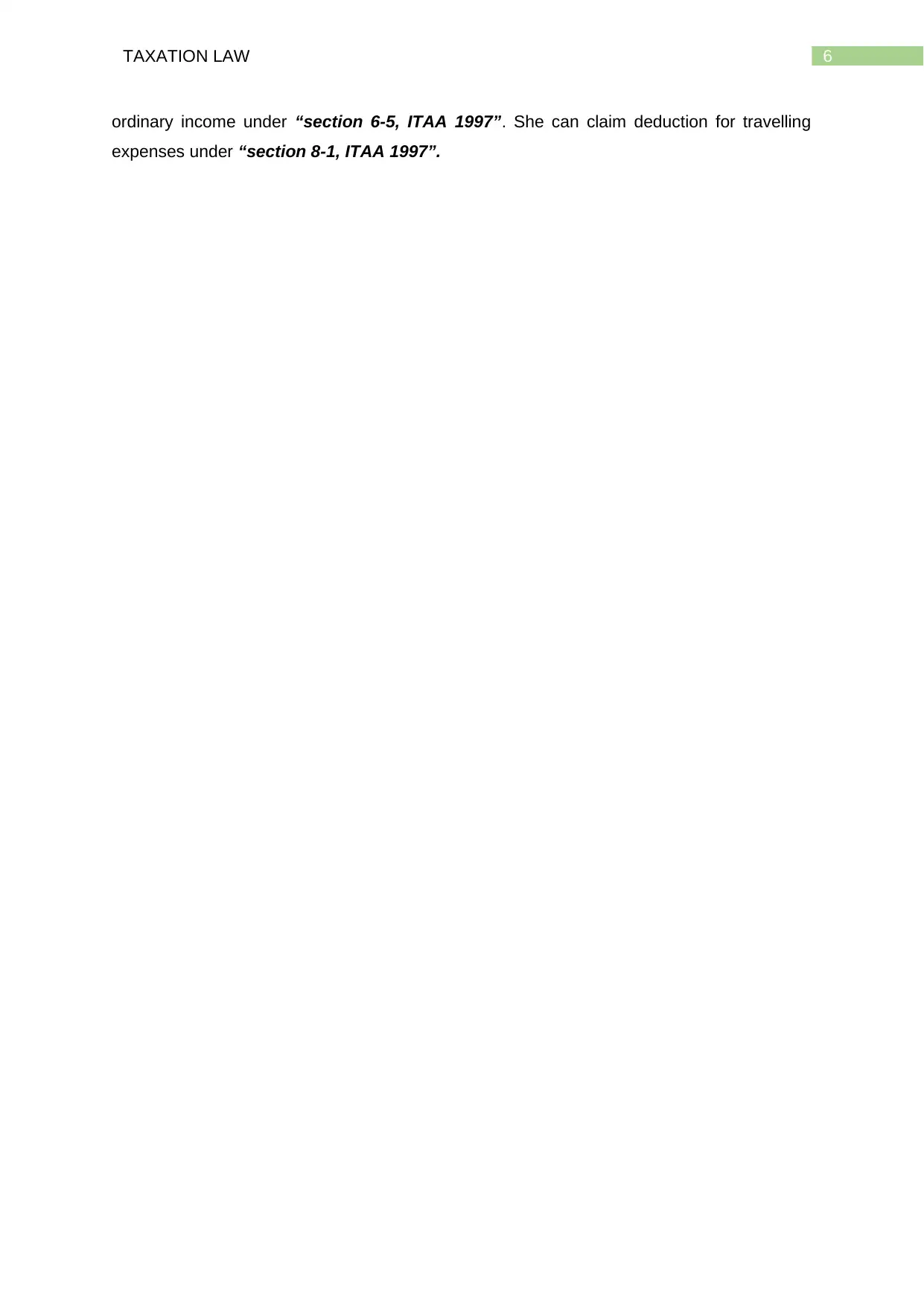
6TAXATION LAW
ordinary income under “section 6-5, ITAA 1997”. She can claim deduction for travelling
expenses under “section 8-1, ITAA 1997”.
ordinary income under “section 6-5, ITAA 1997”. She can claim deduction for travelling
expenses under “section 8-1, ITAA 1997”.
Paraphrase This Document
Need a fresh take? Get an instant paraphrase of this document with our AI Paraphraser
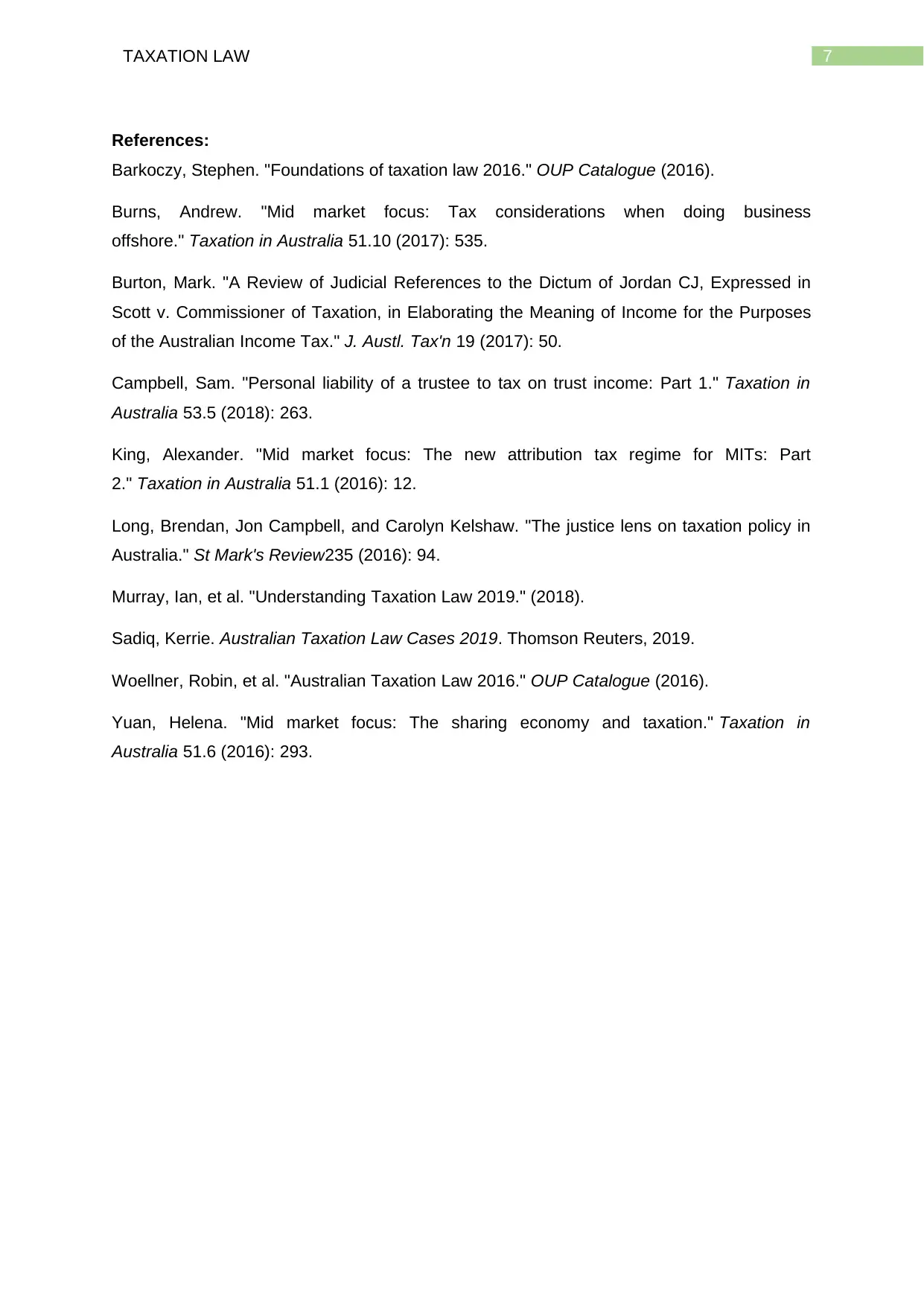
7TAXATION LAW
References:
Barkoczy, Stephen. "Foundations of taxation law 2016." OUP Catalogue (2016).
Burns, Andrew. "Mid market focus: Tax considerations when doing business
offshore." Taxation in Australia 51.10 (2017): 535.
Burton, Mark. "A Review of Judicial References to the Dictum of Jordan CJ, Expressed in
Scott v. Commissioner of Taxation, in Elaborating the Meaning of Income for the Purposes
of the Australian Income Tax." J. Austl. Tax'n 19 (2017): 50.
Campbell, Sam. "Personal liability of a trustee to tax on trust income: Part 1." Taxation in
Australia 53.5 (2018): 263.
King, Alexander. "Mid market focus: The new attribution tax regime for MITs: Part
2." Taxation in Australia 51.1 (2016): 12.
Long, Brendan, Jon Campbell, and Carolyn Kelshaw. "The justice lens on taxation policy in
Australia." St Mark's Review235 (2016): 94.
Murray, Ian, et al. "Understanding Taxation Law 2019." (2018).
Sadiq, Kerrie. Australian Taxation Law Cases 2019. Thomson Reuters, 2019.
Woellner, Robin, et al. "Australian Taxation Law 2016." OUP Catalogue (2016).
Yuan, Helena. "Mid market focus: The sharing economy and taxation." Taxation in
Australia 51.6 (2016): 293.
References:
Barkoczy, Stephen. "Foundations of taxation law 2016." OUP Catalogue (2016).
Burns, Andrew. "Mid market focus: Tax considerations when doing business
offshore." Taxation in Australia 51.10 (2017): 535.
Burton, Mark. "A Review of Judicial References to the Dictum of Jordan CJ, Expressed in
Scott v. Commissioner of Taxation, in Elaborating the Meaning of Income for the Purposes
of the Australian Income Tax." J. Austl. Tax'n 19 (2017): 50.
Campbell, Sam. "Personal liability of a trustee to tax on trust income: Part 1." Taxation in
Australia 53.5 (2018): 263.
King, Alexander. "Mid market focus: The new attribution tax regime for MITs: Part
2." Taxation in Australia 51.1 (2016): 12.
Long, Brendan, Jon Campbell, and Carolyn Kelshaw. "The justice lens on taxation policy in
Australia." St Mark's Review235 (2016): 94.
Murray, Ian, et al. "Understanding Taxation Law 2019." (2018).
Sadiq, Kerrie. Australian Taxation Law Cases 2019. Thomson Reuters, 2019.
Woellner, Robin, et al. "Australian Taxation Law 2016." OUP Catalogue (2016).
Yuan, Helena. "Mid market focus: The sharing economy and taxation." Taxation in
Australia 51.6 (2016): 293.
1 out of 8
Related Documents
Your All-in-One AI-Powered Toolkit for Academic Success.
+13062052269
info@desklib.com
Available 24*7 on WhatsApp / Email
![[object Object]](/_next/static/media/star-bottom.7253800d.svg)
Unlock your academic potential
© 2024 | Zucol Services PVT LTD | All rights reserved.





